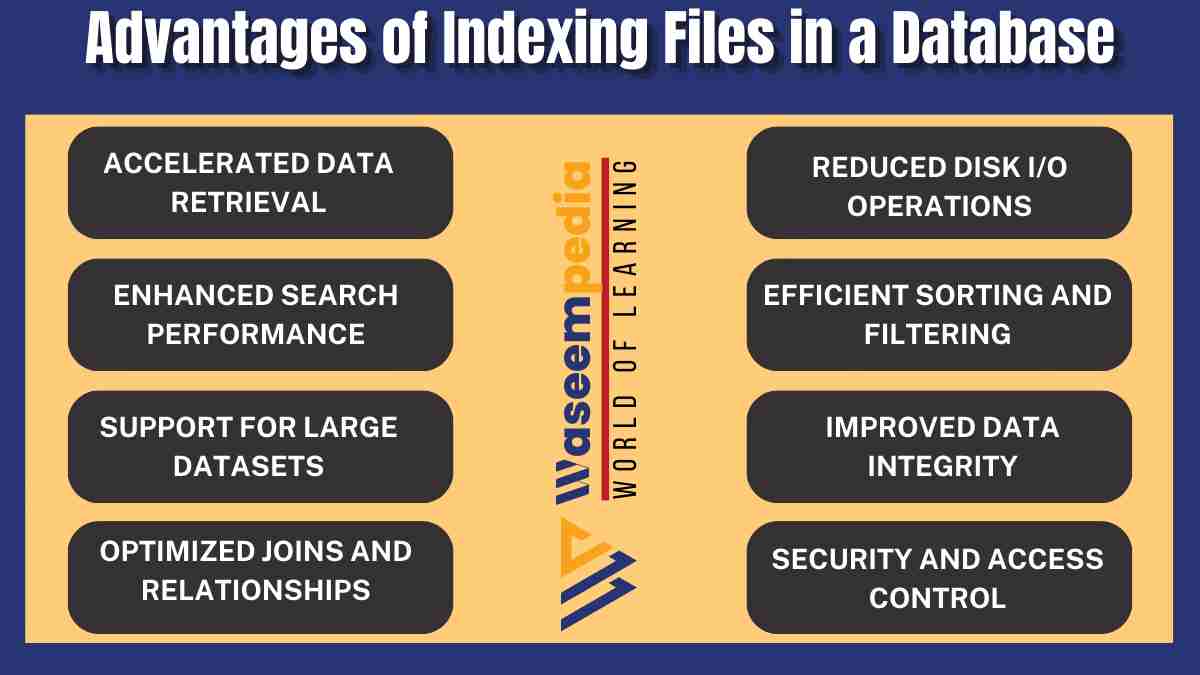Indexing Files in a Database having many advantages such as optimize retrieval speed, minimize resource consumption, reduced disk I/O operations to enhanced search performance and improved data integrity, make it an indispensable technique for modern applications and enhance overall performance. In this article, we will explore the numerous advantages of utilizing files indexing in a database.
Databases serve as the backbone of various applications, ranging from small-scale projects to enterprise-level systems. The speed and efficiency of data retrieval play a pivotal role in ensuring seamless user experiences and efficient resource utilization. Files indexing emerges as a powerful technique to achieve these objectives.

What is Files Indexing?
Files indexing is a method that involves creating a separate data structure, closely associated with the database, that stores the values of specific columns in a pre-sorted order. This structure significantly expedites data retrieval operations by acting as a map to the actual data storage location. When a query is executed, the database engine first consults the index to identify the required data, thereby minimizing the need for resource-intensive full-table scans.

12 Advantages of Indexing Files in a Database
There are many Advantages of Indexing Files in a Database but some are as following.
1. Accelerated Data Retrieval
The foremost advantage of files indexing is the remarkable acceleration of data retrieval. With indexes in place, queries that involve filtering, sorting, or searching based on specific columns can be executed exponentially faster. This enhancement becomes particularly evident as the size of the database grows, as traditional methods might lead to performance bottlenecks.
2. Reduced Disk I/O Operations
In the absence of indexing, retrieving data from a database requires scanning the entire table. This process, known as a full-table scan, can result in extensive disk input/output (I/O) operations and slow down the overall query execution. By leveraging files indexing, the number of disk I/O operations is significantly reduced, as the engine can jump directly to the relevant index entry and retrieve the necessary data.
3. Enhanced Search Performance
Search operations are a fundamental aspect of databases, and their efficiency impacts user satisfaction. Files indexing enables the database engine to swiftly locate the desired data by referring to the index entries. This responsiveness is particularly valuable in applications where users expect real-time results, such as e-commerce platforms or search engines.
4. Efficient Sorting and Filtering
Sorting and filtering large datasets can be resource-intensive tasks. Files indexing optimizes these operations by arranging the indexed columns in a predetermined order. This arrangement facilitates quick access to the data that matches specific criteria, making queries more efficient and responsive.
5. Support for Large Datasets
It is the one of the most impurtant of Advantages of Indexing Files in a Database. As databases accumulate vast amounts of data, maintaining rapid query performance becomes challenging. Files indexing addresses this challenge by ensuring that the growth of the database does not lead to a proportional decline in query speed. Instead, indexes allow databases to handle large volumes of data without compromising on responsiveness.
6. Improved Data Integrity
Indexes not only enhance performance but also contribute to data integrity. By enforcing constraints and unique values, indexes prevent the insertion of duplicate or incorrect data into the database. This safeguard maintains the quality and reliability of the stored information.
7. Optimized Joins and Relationships
Optimized Joins and Relationships is also a Advantages of Files Indexing in a Database. In databases with multiple tables and complex relationships, join operations can be intricate. Files indexing streamlines these operations by facilitating the quick merging of data from different tables based on the indexed columns. This optimization is particularly valuable in relational database systems.
8. Space Utilization and Fragmentation
While indexes consume additional storage space, they also mitigate the effects of data fragmentation. As data is inserted, updated, and deleted over time, fragmentation can lead to decreased query performance. Indexes counteract this by creating a structured layout that reduces fragmentation and maintains efficient data retrieval.
9. Customized Data Organization
Different applications require varying ways of accessing data. Files indexing allows for the customization of data organization based on the application’s specific requirements. This adaptability ensures that each query type is optimized, catering to diverse use cases.
10. Compatibility with Various Database Engines
Files indexing is a versatile technique that aligns with various database engines. Whether using relational databases, NoSQL databases, or other specialized systems, files indexing can be implemented to enhance performance consistently.
11. Scalability and Growth
As databases expand with time, maintaining performance becomes a challenge. Files indexing accommodates scalability by ensuring that new data maintains the same rapid retrieval speed. This scalability is vital for businesses experiencing growth and higher data volumes.
12. Security and Access Control
Files indexing can also contribute to security and access control. By expediting data retrieval, it reduces the time during which sensitive information is exposed. Additionally, indexes can be utilized to enforce access restrictions, ensuring that only authorized users can retrieve specific data.
How to Implement Efficient Indexing
Implementing efficient indexing strategies requires careful consideration and planning. Here are some steps to ensure successful implementation:
Identify High-Volume Queries
Analyze the queries that are frequently executed in your database. These are the ones that would benefit the most from indexing.
Select Appropriate Columns
Choose the columns that are commonly used in the WHERE clause of your queries. These columns are prime candidates for indexing.
Understand Data Types
Different data types require different indexing techniques. Understand the data types of the columns you’re indexing to choose the right index type.
Avoid Over-Indexing
While indexing is beneficial, over-indexing can lead to increased overhead. Be selective and focus on the most important columns.
Consider Composite Indexes
If queries involve multiple columns, consider creating composite indexes that cover those columns together.
Regular Maintenance
Indexes require maintenance to ensure they stay effective. Regularly monitor and update indexes to account for changing data patterns.
Common Indexing Strategies
There are several indexing strategies to consider:
B-Tree Index
This is the most common index type, suitable for equality and range queries.
Hash Index
Ideal for equality comparisons but not well-suited for range queries.
Bitmap Index
Effective for columns with a low cardinality, where each value appears multiple times.
Full-Text Index
Used for efficient text searching within large textual datasets.
Challenges and Considerations
While indexing offers numerous advantages, it’s essential to be aware of potential challenges:
Storage Overhead
Indexes consume storage space, and excessive indexing can impact overall database size.
Maintenance Overhead
Indexes require maintenance during data modifications, which can slow down insertion, update, or delete operations.
Choosing the Right Columns
Incorrectly chosen columns for indexing might not yield desired performance improvements.
Query Plan Changes
An index that is beneficial for one query might not be effective for another, leading to varying performance gains.
Index Fragmentation
Over time, indexes can become fragmented, affecting performance. Regular defragmentation might be necessary.
Related FAQ’s
What is files indexing in a database?
Files indexing in a database refers to the technique of creating a separate data structure that stores the values of specific columns in a pre-sorted order, optimizing data retrieval speed.
How does files indexing enhance search performance?
Files indexing enables rapid search performance by acting as a map to data storage locations, reducing the need for resource-intensive full-table scans.
Can files indexing handle large datasets efficiently?
Yes, files indexing is designed to handle large datasets efficiently by maintaining rapid query performance as the database grows.
Does files indexing contribute to data integrity?
Yes, files indexing improves data integrity by enforcing constraints and unique values, preventing the insertion of incorrect or duplicate data.
Is files indexing compatible with different database engines?
Absolutely, files indexing can be implemented across various database engines, including relational and NoSQL databases, to consistently enhance performance.

